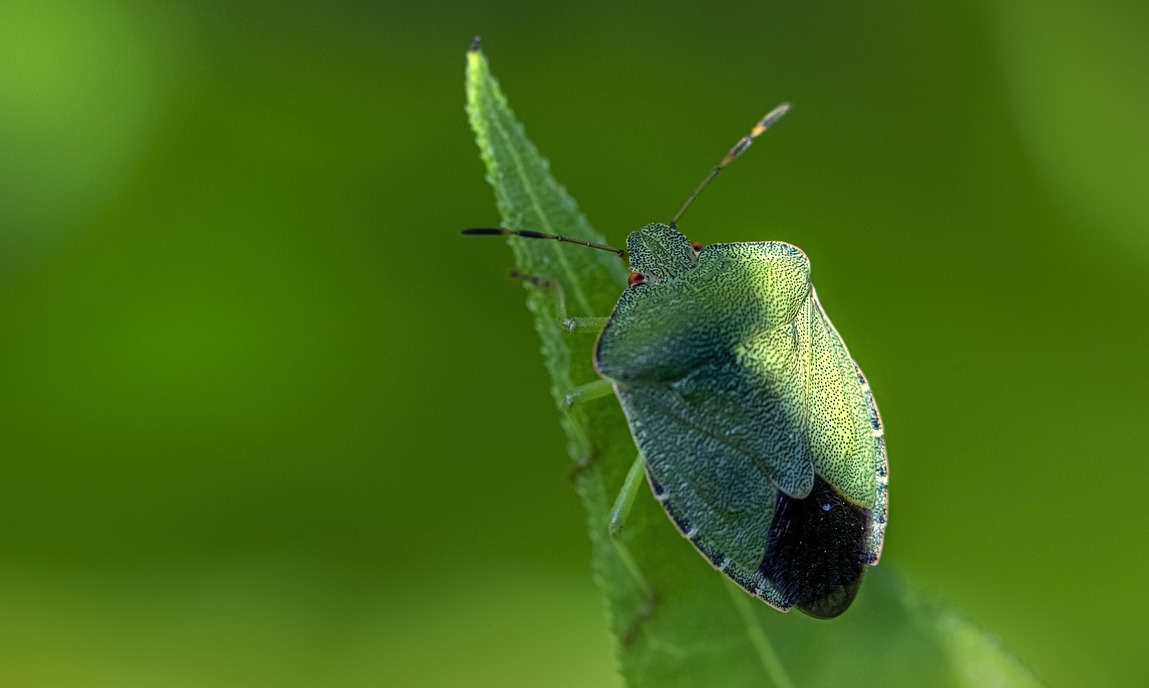Hi @nikik
It looks like thats a shield bug of some sort. Shield bugs can cause damage to plants as they suck sap and fluids from the plant. They have piercing-sucking mouthparts that they use to pierce plant tissues and extract sap.

The term "shield bug" can also be used to refer to other insects with similar shield-like body shapes, such as the coreid bugs or certain beetles. They have a distinctive shape with a triangular scutellum, which is an extension of the thorax that covers the wings. The colouration of shield bugs varies widely, but they often have mottled or bright colours, like your bright green one that blends with the Sambucus (Elderberry) that its been found on. These colours help them camouflage or warn predators.
Shield bugs undergo incomplete metamorphosis, which means they have three life stages: egg, nymph, and adult. After mating, females lay eggs on plant leaves or stems. The eggs hatch into nymphs, which resemble smaller versions of the adults but lack fully developed wings. Nymphs go through several moults before reaching adulthood.
How to get rid of shield bugs
The best way to get rid of them is to either pick them off by hand or to use a mix of 1/4 washing up liquid and water. Spray this on the underside of the leaves to kill off the bugs.
However, they very rarely tend to kill plants so I tolerate them as I believe they have a wider importance for ecology and garden health. Try and limit the removal of insects unless they are really damaging your plants. Usually when this happens it's because things in the garden are out of balance.
Ideally, having predatory insects pick them off is best such as ladybirds or even birds in the garden so always try and encourage these as well. The same method can be used for aphids too!
Hope that helps!
Lee
Hi @nikik
It looks like thats a shield bug of some sort. Shield bugs can cause damage to plants as they suck sap and fluids from the plant. They have piercing-sucking mouthparts that they use to pierce plant tissues and extract sap.

The term "shield bug" can also be used to refer to other insects with similar shield-like body shapes, such as the coreid bugs or certain beetles. They have a distinctive shape with a triangular scutellum, which is an extension of the thorax that covers the wings. The colouration of shield bugs varies widely, but they often have mottled or bright colours, like your bright green one that blends with the Sambucus (Elderberry) that its been found on. These colours help them camouflage or warn predators.
Shield bugs undergo incomplete metamorphosis, which means they have three life stages: egg, nymph, and adult. After mating, females lay eggs on plant leaves or stems. The eggs hatch into nymphs, which resemble smaller versions of the adults but lack fully developed wings. Nymphs go through several moults before reaching adulthood.
How to get rid of shield bugs
The best way to get rid of them is to either pick them off by hand or to use a mix of 1/4 washing up liquid and water. Spray this on the underside of the leaves to kill off the bugs.
However, they very rarely tend to kill plants so I tolerate them as I believe they have a wider importance for ecology and garden health. Try and limit the removal of insects unless they are really damaging your plants. Usually when this happens it's because things in the garden are out of balance.
Ideally, having predatory insects pick them off is best such as ladybirds or even birds in the garden so always try and encourage these as well. The same method can be used for aphids too!
Hope that helps!
Lee
 Lee Burkhill: Award Winning Designer & BBC 1's Garden Rescue Presenters Official Blog
Lee Burkhill: Award Winning Designer & BBC 1's Garden Rescue Presenters Official Blog



